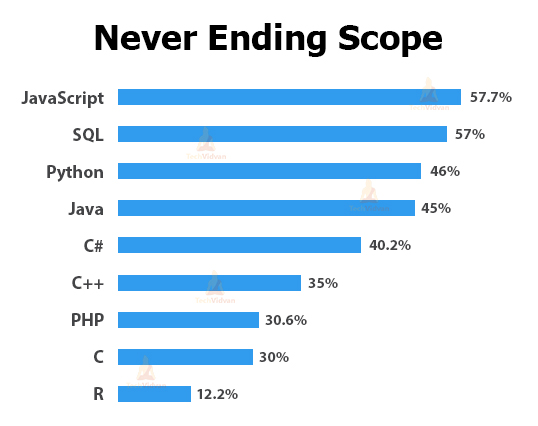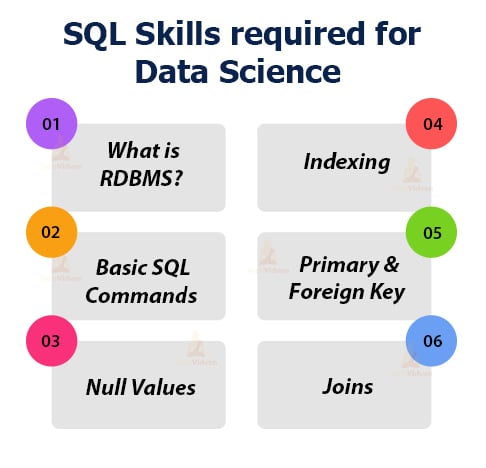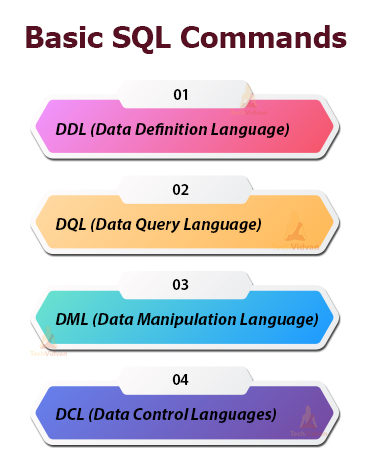SQL for Data Science – Why is SQL crucial for Data Science?
In this article, you will learn the importance of SQL for Data Science to master the field.
The world is moving towards digitalization and the data has a very crucial role to play in every field. Various industries are collecting billions of customers’ data every day. The management and analysis of this data require a certain skill set for extracting the meaning out of it.
Now you must be wondering how SQL comes in Data Science? But, SQL always goes hand in hand with Data Science because Big Data lies at its core and all this Big Data needs to be stored in a database. SQL for Data Science is therefore very important for handling such large amounts of data.
In this article, we will understand the importance of SQL in Data Science.
What is SQL?
SQL stands for Structured Query Language which is a standard query language designed for querying and managing relational databases. It allows you to create, maintain, and retrieve data from a relational database. By using SQL, you can insert, update, delete, modify, and retrieve data through various simple commands.
The reason that it is so popular is that it is very easy to use and understand. Thus, the syntax used in SQL is quite similar to the words of the English language.
There are various SQL databases available such as SQLite, MySQL, Oracle, Microsoft SQL Server, etc. Each one of these is best in different scenarios based on the requirements of the data.
In simple words, we can say that if you want to play with data, you should definitely have hands-on SQL. The different reasons that prove the significance of SQL for Data Science are:
Importance of SQL for Data Science
Below are the points that will help you in understanding the importance of SQL for Data Science.
Let’s have a look on them.
1. Easy to Learn and Use
SQL is always appreciated for its simplicity because of its easy syntax that makes use of the English language words. It helps you to easily understand the concepts, unlike some other complex programming languages which require a lot more effort and conceptual understanding.
If you are a newbie in the field of Data Science then SQL is the perfect starting point for you. You can easily query and manipulate your data for extracting insights from it with just a few lines of code.
2. Understanding your Data
Data is the core element in Data Science. For doing Data Science, you must be able to extract the real meaning out of your data in which SQL is going to help you.
SQL for Data Science provides you with the ability to explore and visualize your dataset efficiently for producing accurate results. It will help you to handle the missing and null values, outliers and other anomalies in the data.
SQL for Data Science also helps you to have a better understanding of your dataset and organize it according to your needs.
3. SQL is Everywhere
SQL for Data Science has become the first choice of almost all the leading organizations. It is becoming a standard to use SQL for Data Science and many of the business giants like Facebook, Google, Amazon, Netflix, Uber, etc. All of the above mentioned are using SQL for performing various Data Science processes.
For any job related to Data like Data Scientist, Data Analyst, Database Administrator, Business Analyst, etc. you must have SQL in your tool kit because you will definitely require SQL for interacting with your data.
4. SQL Integrates with Scripting Languages
Along with data querying and manipulation, SQL also helps in data visualization to some extent.
While working on a project as a Data Scientist, you will sometimes need to explain your findings to the other team members of the organization. The explanation should be in such a way that it becomes easy to understand.
In such cases, SQL for Data Science will help you as it easily integrates with the most commonly used scripting languages such as R programming and Python. Some SQL libraries like SQLite, MySQLdb, etc. also allow you to connect the client application with your database. It makes the development process a bit easier.
5. SQL is Declarative
SQL is a nonprocedural language. One of the important advantages of SQL over other conventional programming languages like R, Python is that in SQL you only need to specify what you want to do without specifying the necessary steps for doing it.
Using SQL for Data Science allows you to perform complex operations in comparatively less time and code.
6. Manage Large Volumes of Data
Data Science involves the collection and management of huge volumes of data in the database. But using spreadsheets for such large amounts of data becomes a tedious job. Thus, SQL provides you the suitable resources for dealing with such large amounts of data and gaining insights from it.
Learning SQL for Data Science will also make it easy for you to learn NoSQL databases. These are popular for working with big volumes of data and provides better flexibility and scalability.
7. Never Ending Scope
Despite being old, SQL is still preferred by a large number of Data Scientists for handling the tasks related to data storage.
According to the 2017 and 2018 Developer Survey of StackOverflow, SQL for Data Science proved to be more popular than the widely used programming languages R and Python.
After the introduction of many new technologies in the market like NoSQL, Hadoop, etc., SQL is still preferred by Data Scientists with all levels of experience.
Even the 2019 survey of StackOverflow shows SQL as the third most popular programming language.
However, the complete details of the survey are yet not released.
SQL Skills required for Data Science
To start with Data Science you must have the knowledge of the basic concepts and queries of SQL for managing your data in the database.
Let us see the different SQL skills that a Data Scientist must know.
1. What is RDBMS?
As a Data Scientist, you must have a thorough knowledge of RDBMS as it is the most commonly used database system.
SQL is based on RDBMS. RDBMS stands for Relational Database Management System and follows the principles of the relational model. In RDBMS, the data is stored in the form of related tables. A table is basically a collection of several rows and columns. The access to data becomes easy in RDBMS because of the well-organized tables.
Some other advanced database management systems like MySQL, ORACLE, Microsoft Access, etc. are also based on RDBMS.
2. Basic SQL Commands
The basic types of SQL commands that a Data Scientist must know are:
A. DDL (Data Definition Language)
The DDL commands are those SQL commands which are used for defining the structure of the database. The various DDL commands allow you to manage the database schema by creating and modifying the database objects.
The DDL commands are :
- Create – This command helps in creating new databases or database objects like tables.
- Alter – The alter command allows you to alter the structure of the database. The alter command enables you to add, delete, drop, and modify the columns of a database table.
- Drop – The drop command allows you to delete the database objects. It removes the entire structure of the database or the object as specified by the user.
- Truncate – The truncate command allows you to remove all the records or rows from a table.
- Rename – The rename command allows you to rename an already existing database object.
- Comment – The comment statements are used for adding metadata about the database in the data dictionary.
B. DQL (Data Query Language)
The collection of the SQL commands used for retrieving the data from the database comes under the category of DQL commands.
The DQL command includes:
- Select – The various select statements are used for retrieving data from a database.
C. DML (Data Manipulation Language)
The SQL commands used for manipulating the data comes under the category of DML statements.
- Insert – The insert command allows you to add new information to the database.
- Update – The update statement allows you to update the existing data in the database.
- Delete – The delete statements are used for deleting the records or rows from a table.
D. DCL (Data Control Languages)
The DCL commands deal with tasks related to rights, permissions, and control of the database system. The DCL commands are:
- Grant – The grant command grants a user the right to access the database.
- Revoke – The revoke command withdraws the access rights given by the grant command.
3. Null Values
Null values should not be misunderstood with zero values or spaces in a field. The Null values are used for fields having missing or no values.
4. Indexing
We always refer to the index of a book for finding something quickly. Indexes are tables that work in a similar way to speed up the searching and retrieval of data from the database.
5. Primary and Foreign Key
The primary key represents a single column or a group of columns that enables you to uniquely identify each and every row of a table. A foreign key represents a column or a group of columns in a table and is used to establish a relation between two tables.
6. Joins
The join operations help to combine the rows of two or more tables by using a common column between them.
Summary
After going through this article, you all might have understood the importance of SQL for Data Science and how you can start your Data Science journey by learning SQL. Mastering SQL will help you to understand and manage your data in an efficient way for making better data-driven decisions.
That was all about TechVidvan’s SQL for Data Science article.


